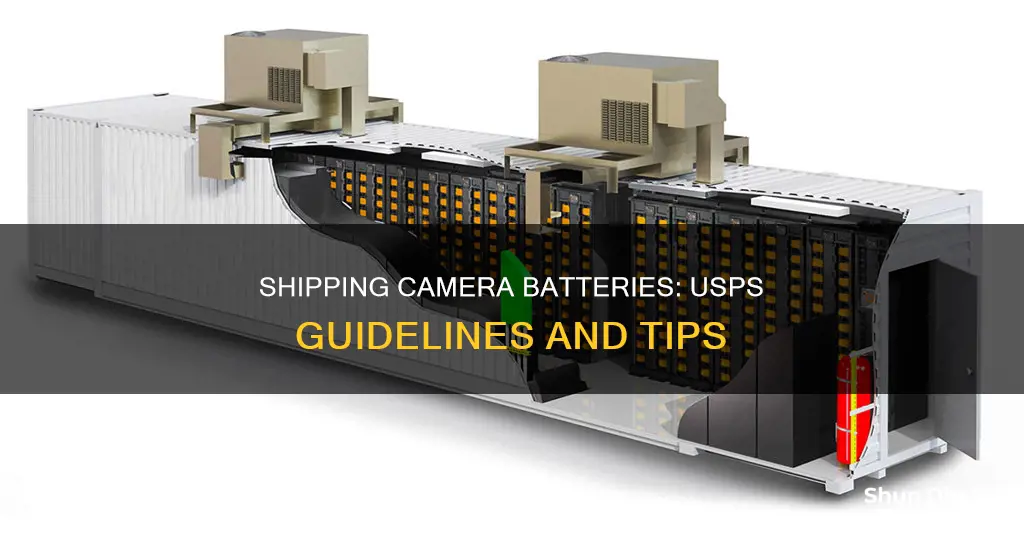
Shipping camera batteries via USPS is a complex process due to safety concerns surrounding lithium batteries. USPS has strict guidelines for mailing lithium-ion and lithium metal batteries, which are commonly found in cameras. These guidelines have been updated over time, causing confusion among shippers. It is important to distinguish between new and pre-owned, damaged, or defective batteries, as the latter cannot be shipped via air transportation and must be marked as Restricted Electronic Device and Surface Transportation Only. Shippers must also comply with specific packaging instructions to prevent batteries from short-circuiting, overheating, or catching fire. Understanding and adhering to these regulations is crucial to ensure safety and avoid fines or other penalties.
| Characteristics | Values |
|---|---|
| Shipping method | USPS |
| Battery type | Lithium-ion |
| Battery packaging | Must follow USPS Packaging Instructions 9D to prevent short-circuiting, overheating, or catching fire |
| Outer packaging | Must be strong, sealed, and cushioned to prevent movement |
| Labeling | Must include "Restricted Electronic Device" and "Surface Transportation Only" |
| Shipping class | USPS Retail Ground, Parcel Select, Parcel Return Service, or Ground Return Service |
| Markings | Lithium battery marks are required |
| International packaging | Solid and rigid packaging that is adequately sized to display lithium battery mark without folding |
| Exceptions | Fully regulated, damaged, or recalled batteries cannot be shipped via USPS |
What You'll Learn

USPS Lithium Battery Shipping: What You Need to Know
Lithium batteries are a common power source for many electronic devices, from cameras to mobile phones and laptops. With the rise of e-commerce, shipping lithium batteries has become an increasingly common practice. However, it's important to be aware of the safety regulations and requirements when sending these batteries through the mail. Here's what you need to know about shipping lithium batteries via the United States Postal Service (USPS).
Yes, you can ship lithium batteries through the USPS, but there are specific types of lithium batteries that are eligible for shipment. These include:
- Lithium-ion (rechargeable) battery, UN3480
- Lithium metal battery, UN3090
- Lithium-ion (rechargeable) battery contained in equipment, UN3481
- Lithium-ion (rechargeable) battery packed with equipment, UN3481
- Lithium metal (or lithium alloy) battery contained in equipment, UN3091
- Lithium metal (or lithium alloy) battery packed with equipment, UN3091
It's important to note that fully regulated, damaged, or recalled lithium batteries are prohibited from being shipped via USPS. If the batteries require a Class 9 hazard label per 49 CFR 173.185(c) requirements, they cannot be shipped through the mail.
Packaging Requirements:
To ensure safe transport, it is crucial to follow strict packaging instructions. You must adhere to USPS Packaging Instructions 9D to prevent batteries from short-circuiting, overheating, or catching fire. The outer packaging should be strong, sealed, and cushioned to prevent movement and protect the batteries.
For international shipments, solid and rigid packaging is required to prevent crushing or exposure. The package must also be adequately sized to display the lithium battery mark and any applicable telephone numbers without folding. International shipments in padded and poly bags are only permitted for button cell batteries under specific circumstances.
Domestic vs. International Shipping:
USPS has different regulations for domestic and international shipments. For domestic shipments, lithium metal and lithium-ion cells and batteries can be mailed in limited quantities via air or surface transportation when installed in or packed with the equipment they are intended to operate. However, batteries without equipment are typically limited to surface transportation only.
For international shipments, it's crucial to refer to the most up-to-date guidelines provided by the USPS, as these regulations can change.
Used or Pre-Owned Lithium Batteries:
In recent years, there has been an increase in incidents involving lithium batteries, leading to new restrictions on used electronics. The USPS now requires that pre-owned, damaged, or defective electronic devices containing lithium batteries be shipped via ground transportation only. This includes items such as cell phones, tablets, laptops, cameras, and power tools. These packages must also be marked as "Restricted Electronic Device" and "Surface Transportation Only."
Shipping lithium batteries via USPS requires careful attention to safety regulations and packaging instructions. While it can be a cost-effective option, it's important to stay up-to-date with the latest guidelines to ensure compliance and safe transport. Always refer to the most recent version of USPS Publication 52 ("Hazardous, Restricted, and Perishable Mail") for detailed information on shipping lithium batteries through the mail.
Charging the Polaroid Snap Touch: A Step-by-Step Guide
You may want to see also

Packaging Requirements for Lithium Batteries
When shipping lithium batteries, it is essential to adhere to the packaging requirements to ensure safety and compliance with regulations. Here are the key considerations for the packaging requirements:
Prevent Movement and Short Circuiting:
Lithium-ion batteries must be packaged securely to prevent movement within the outer package and accidental activation of the equipment. Inner packaging must completely enclose each battery, preventing contact with other equipment or conductive materials. The packaging should also be designed to prevent short-circuiting.
Outer Packaging Requirements:
The outer packaging must be strong, sealed, and cushioned to prevent movement. It should be made of rigid, impact-resistant material to withstand transportation. For international shipping, the packaging must be solid and adequately sized to display the lithium battery mark without folding.
Prohibited Packaging Materials:
Lithium-ion batteries cannot be packaged in metallic inner packaging. Instead, use non-metallic, non-conductive, and absorbent materials for inner packaging. For damaged or recalled batteries, the inner packaging must be made of cushioning material that is non-combustible, non-conductive, and absorbent.
Hazard Communication Label:
Each package must display the required hazard communication label, indicating the type of battery and potential risks. The labels must comply with the regulations of the specific mode of transportation, such as air, sea, or ground transport.
Special Considerations for Damaged or Recalled Batteries:
Damaged or recalled lithium-ion batteries have stricter packaging requirements. They must be transported only by highway, rail, or vessel. The inner packaging must be made of non-metallic, non-combustible, non-conductive, and absorbent material. The outer packaging must display the appropriate labels, such as "Damaged/Defective Lithium-ion Battery."
Prototype Batteries:
Prototype batteries have slightly different requirements. They can use non-combustible, non-flammable cushioning to prevent vibration and contact with other materials. If the batteries weigh more than 60 pounds, they must be packed in individual packaging. The shipping papers must include the phrase "Transport in accordance with §173.185."
Watt-Hour and Lithium Content Limits:
The packaging requirements may vary depending on the size and watt-hour rating of the battery. In the United States, if a lithium-ion cell does not exceed 20 watt-hours, and a lithium-ion battery does not exceed 100 watt-hours, you are exempt from using UN packaging. Similar exemptions exist for lithium metal batteries with low lithium content.
Packaging for Recycling or Disposal:
Batteries being shipped for recycling or disposal are exempt from testing and record-keeping requirements but must meet the typical packaging requirements for lithium-ion batteries.
Maximizing Camera Battery Life: Tips and Tricks
You may want to see also

Domestic vs. International Lithium Battery Shipping
Lithium batteries are considered dangerous goods and must be handled with care when shipping. There are important differences to note between domestic and international lithium battery shipping regulations. Here is a detailed guide to help you understand the requirements for each:
Domestic Shipping:
When shipping lithium batteries within the country, it's important to refer to the United States Postal Service's Publication 52, also known as "Pub 52." This document outlines the specific guidelines for safely transporting lithium batteries through the USPS. Let's go over some key points:
- Eligible Battery Types: There are six types of lithium batteries that can be shipped domestically through the USPS. These include lithium-ion (rechargeable) batteries, lithium metal batteries, and their variations packed with or contained in equipment.
- Packaging Instructions: Pay close attention to USPS Packaging Instruction 9D. It dictates that you must use strong, sealed, and cushioned packaging to prevent movement and protect the batteries. The package must also be rigid and adequately sized to display the lithium battery mark without folding.
- Battery Quantity and Weight Limits: Domestic shipping has specific limits on the number and weight of batteries shipped. For example, each mailpiece containing lithium-ion batteries without equipment must not exceed 5 pounds, and the total watt-hour rating for each battery must not exceed 100 Wh.
- Used, Damaged, or Defective Devices: If you're shipping used, damaged, or defective electronic devices containing lithium batteries, they must be mailed via domestic surface transportation only. Additionally, ensure that the package is marked with "Restricted Electronic Device" and "Surface Transportation Only."
International Shipping:
Now, let's shift our focus to international lithium battery shipping:
- Packaging Requirements: International packaging standards are more stringent. Solid, rigid packaging is required to prevent crushing or exposure. Padded and poly bags are generally not permitted for international shipments, except in specific circumstances involving button cell batteries.
- Mailing Restrictions: When shipping internationally through the USPS, fully regulated, damaged, or recalled lithium batteries are prohibited. If the batteries require a Class 9 hazard label per 49 CFR 173.185(c) requirements, they cannot be shipped via USPS.
- Harmonization Challenges: USPS lithium battery shipping requirements might not align perfectly with regulations from other intermodal carriers and international organizations. This lack of harmonization can make it challenging to ensure compliance with all applicable standards.
In conclusion, shipping lithium batteries, whether domestically or internationally, demands strict adherence to safety protocols. Domestic shipping through USPS allows for eligible battery types, specific packaging instructions, and weight limits. On the other hand, international shipping prohibits certain types of batteries, necessitates rigid packaging, and presents harmonization challenges with other carriers and jurisdictions. Always refer to the most up-to-date guidelines from official sources before shipping lithium batteries to ensure compliance and safety.
Panasonic Lumix DMC-LX10K: Battery Life Explained
You may want to see also

Shipping Used Camera Batteries
Understanding the Regulations
The United States Postal Service (USPS) has strict regulations regarding the shipment of lithium batteries, which are commonly found in cameras. These regulations are outlined in Publication 52, also known as "Hazardous, Restricted, and Perishable Mail." It's important to familiarise yourself with these regulations before attempting to ship used camera batteries.
Determining Battery Type
The first step is to determine the type of lithium battery you are shipping. There are six types of lithium batteries eligible for shipment through USPS, including lithium-ion (rechargeable) batteries and lithium metal batteries. Identify which category your camera battery falls under.
Packaging Requirements
Pay close attention to the packaging requirements specified by USPS. You must follow their Packaging Instructions 9D strictly to prevent batteries from short-circuiting, overheating, or catching fire. The outer packaging should be strong, sealed, and cushioned to prevent movement. For international shipments, solid and rigid packaging is required to prevent crushing or exposure.
Markings and Labelling
Ensure that your package has the correct markings and labels. The USPS requires packages containing pre-owned, damaged, or defective electronic devices with lithium batteries to be marked as "Restricted Electronic Device" and "Surface Transportation Only." These markings must be clearly visible on the package.
Shipping Method
Used camera batteries containing lithium batteries cannot be shipped via air transportation. They must be sent via ground transportation options such as USPS Retail Ground, Parcel Select, Parcel Return Service, or Ground Return Service. These services ensure that the batteries are transported safely by surface mail only.
Alternative Carriers
If you encounter challenges with USPS, consider alternative carriers such as FedEx or UPS. However, always ensure that you comply with their specific regulations and guidelines for shipping used camera batteries.
Remember, safety is a top priority when shipping lithium batteries. Always follow the regulations and guidelines provided by the carrier to ensure a smooth and secure shipping process.
Charging Your Fujifilm Waterproof Camera: A Step-by-Step Guide
You may want to see also

USPS Label Requirements for Lithium Batteries
When shipping lithium batteries with USPS, you must adhere to the following labelling requirements:
Domestic Shipping
Lithium Metal Batteries
If the lithium metal batteries are properly installed in the equipment they are intended to operate, no markings are required when mailed by air or surface transportation. However, if the number of lithium metal cells exceeds four, or the number of batteries exceeds two, markings on the outer packaging must indicate:
- The package contains lithium metal cells or batteries.
- The package must be handled with care, and that a flammable hazard exists if the package is damaged.
- Special procedures must be followed in the event the package is damaged, including inspection and repacking if necessary.
- A telephone number for additional information.
If the lithium metal batteries are packed with the equipment they are intended to operate, markings on the outer packaging must indicate:
- The package contains lithium metal cells or batteries.
- The package must be handled with care, and that a flammable hazard exists if the package is damaged.
- Special procedures must be followed in the event the package is damaged, including inspection and repacking if necessary.
- A telephone number for additional information.
If the lithium metal batteries are being shipped without equipment, the outer packaging must be marked on the address side with:
- "Surface Mail Only, Primary Lithium Batteries — Forbidden for Transportation Aboard Passenger Aircraft" or
- "Surface Mail Only, Lithium Metal Batteries — Forbidden for Transportation Aboard Passenger Aircraft".
Additionally, markings on the outer packaging must indicate:
- The package contains lithium metal cells or batteries.
- The package must be handled with care, and that a flammable hazard exists if the package is damaged.
- Special procedures must be followed in the event the package is damaged, including inspection and repacking if necessary.
- A telephone number for additional information.
Lithium-ion Batteries
If the lithium-ion batteries are properly installed in the equipment they are intended to operate, no markings are required. However, if the number of lithium-ion cells exceeds four, or the number of batteries exceeds two, markings on the outer packaging must indicate:
- The package contains lithium-ion cells or batteries.
- The package must be handled with care, and that a flammable hazard exists if the package is damaged.
- Special procedures must be followed in the event the package is damaged, including inspection and repacking if necessary.
- A telephone number for additional information.
If the lithium-ion batteries are packed with the equipment they are intended to operate, markings on the outer packaging must indicate:
- The package contains lithium-ion cells or batteries.
- The package must be handled with care, and that a flammable hazard exists if the package is damaged.
- Special procedures must be followed in the event the package is damaged, including inspection and repacking if necessary.
- A telephone number for additional information.
If the lithium-ion batteries are being shipped without equipment, markings on the outer packaging must indicate:
- The package contains lithium-ion cells or batteries.
- The package must be handled with care, and that a flammable hazard exists if the package is damaged.
- Special procedures must be followed in the event the package is damaged, including inspection and repacking if necessary.
- A telephone number for additional information.
The outside of the package must also be marked on the address side with:
"Package Contains Lithium-ion Batteries (no lithium metal). No other markings are permitted when mailed by air transportation."
International Shipping
Lithium batteries, whether lithium metal or lithium-ion, are only mailable when they are properly installed in the equipment they are intended to operate. No markings or labels identifying the contents as lithium batteries are permitted.
Replacing Sanyo Camera Battery: Step-by-Step Guide
You may want to see also
Frequently asked questions
Yes, you can ship camera batteries with USPS, but there are some restrictions.
There are currently six types of lithium batteries eligible for shipment in varying domestic or international quantities:
- Lithium-ion (rechargeable) battery, UN3480
- Lithium metal battery, UN3090
- Lithium-ion (rechargeable) battery contained in equipment, UN3481
- Lithium-ion (rechargeable) battery packed with equipment, UN3481
- Lithium metal (or lithium alloy) battery contained in equipment, UN3091
- Lithium metal (or lithium alloy) battery packed with equipment, UN3091
You must follow USPS Packaging Instructions 9D to prevent batteries from short-circuiting, overheating, or catching fire. Your outer packaging should be strong, sealed, and cushioned to prevent movement. International packaging requirements include solid, rigid packaging to prevent crushing or exposure.
Packages containing pre-owned, damaged, or defective electronic devices with lithium batteries must be marked as "Restricted Electronic Device" and "Surface Transportation Only," in addition to any other applicable markings.
Yes, you can ship a camera with the lithium-ion battery installed. However, ensure that you follow the packaging and marking requirements mentioned above.







